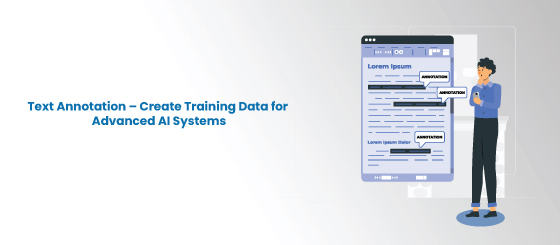
“You nailed it!”
Reading a sentence like the above, a human would get the meaning, context, and intent behind the statement – that the person is being complimented/ appreciated for doing something perfectly. However, a Natural Language Processing (NLP) model might have trouble understanding the correct context and intent and may interpret it literally as putting a nail somewhere, or even a negative sentiment, completely misunderstanding the sentence. One of the biggest technological breakthroughs of recent times is NLP, where machines, trained on qualitative datasets, are evolving to understand how humans talk, comprehend, respond, analyze and even mimic human conversations and sentiment-led behavior. It has been the driving force in the development of chatbots, voice recognition, text-to-speech tools, virtual assistants, to name a few.
To make AI learn, comprehend and respond like humans, we must give the machines perspective, understanding, and feeling – three concepts integral to the human psyche. This is where Text Annotation comes in – a type of machine learning process that assigns meaning to blocks of text to provide AI models with additional information that may help them deliver a more accurate interpretation of the text at hand. Let’s explore this a little more.
Text annotation in machine learning is the process of identifying and labeling a digital file or document and its contents with additional information or metadata to define sentence characteristics. This is done by highlighting criteria such as different parts of speech in a sentence, grammar, syntax, keywords, phrases, emotions, sentiments, sarcasm, etc., depending on the scope of the task at hand.
Text annotation helps in preparing datasets that can be used to train machines how to read, understand and analyze the rather complex human language, helping them become better at understanding and mimicking human conversations and behavior. The ultimate goal is to enrich the machine-human technological interactions.
To achieve precision and accuracy, the experts deploy standout text annotation techniques. What are they? Let’s find out.
The process of annotating text usually involves actions that interact with the digital contextual text. It usually contains highlighted or underlined key sections of text, along with notes around margins, to ensure that the target reader, in this case, a computer, can quickly and easily understand, index, and store the important elements of the database for future use.
The nature of the project and related use cases determines what type of text annotation technique will be most productive.
Listed below are seven of the most widely used text annotation techniques.
As the name denotes, this technique helps machines understand the attitude and emotions associated with a piece of text. It is a crucial technique of text annotation as it allows AI models to detect specific sentiments, hidden connotations, and opinions. The annotators review a given text and label it as positive, negative, or neutral, as otherwise, the machines can easily misinterpret the sentence. From brand monitoring, employee engagement, in-depth customer insights to market research and analysis, and so much more, sentiment annotation has a broad range of applications. By interpreting text data, organizations can get actionable insights from diverse and disparate information sources online.
While sentiment annotation involves labeling the emotional aspect of a sentence, intent annotation focuses on identifying the desire/ intention of the users. It analyzes the need or desire behind a text and classifies it as request, command, or acknowledgement through appropriate labeling.
Used to identify, tag, and attribute multiple entities with the text data, entity annotation is the most vital text annotation technique and is pivotal in chatbot training. Focused on extracting, locating, and tagging entities before feeding the data into the system, it is often used for improving search-related functions and user experience. Entity annotation can further be divided into the following subsets:
This technique involves linking various entities of a document or piece of text to better understand the structure of the text and the relationship between the different parts of a document.
The most elementary approach of text annotation, this type focuses on classifying an entire body of text, based on content type, intent, sentiment, and subject, with a single label. It is often used for labeling topics, analyzing intent & emotional sentiment, and detecting spam. The datasets are fed into the system based on predefined criteria, which can be accessed by the machines to generate a response. A few use cases where datasets can be developed to train ML and DL (Machine Learning & Deep Learning) models in this category would be:
Document Classification: involves tagging documents for sorting text-based content efficiently. Academic institutions and businesses leverage it to build public and private databases of contextual resource materials, collaborative publishing, and more.
Product Classification: is the process of sorting specific products or services into various categories and is often used by e-commerce platforms to improve search relevance, enhancing product reach and user experience.
This form of text annotation involves a bit of all the techniques discussed so far, with the finer difference being that the process is done on language data. It includes an additional annotation type, phonetics., where nuances like natural pauses, stress, intonations, and more are tagged as well. This approach is of specific importance for training machine translation models.
This type of text annotation attributes various tags to text involving concepts and entities, such as topics, people, or places. It provides additional information on words and phrases that explain user intent or domain-specific information and is particularly useful in virtual assistants and chatbots.
In a nutshell, text annotation aims at creating qualitative project-driven datasets, relevant to a particular AI model. Since these high-quality datasets are instrumental in training machines to perform as instructed, therefore, the training data must begin with accurate, in-depth, and comprehensive text annotation. Therefore, text labeling should be done by experts who painstakingly tag every aspect of a sentence ensuring nothing crucial for machine learning is overlooked and one gets the most precise AI training data for their modules.